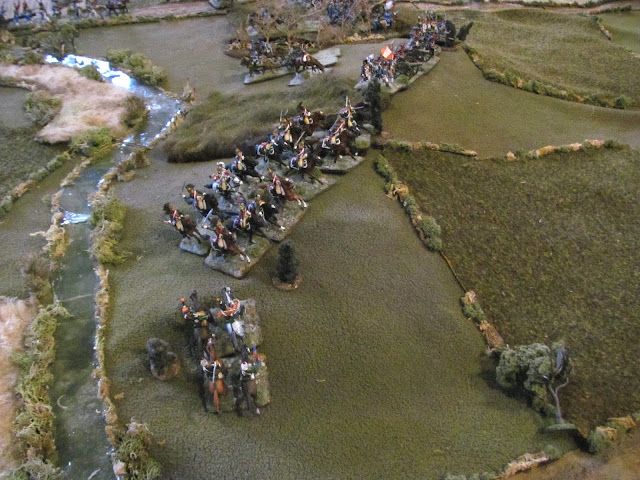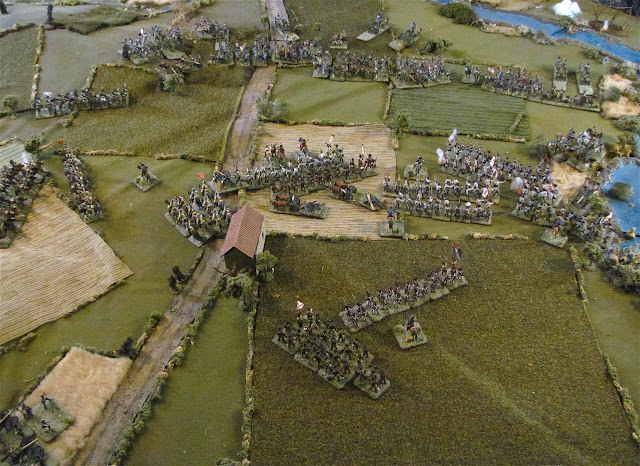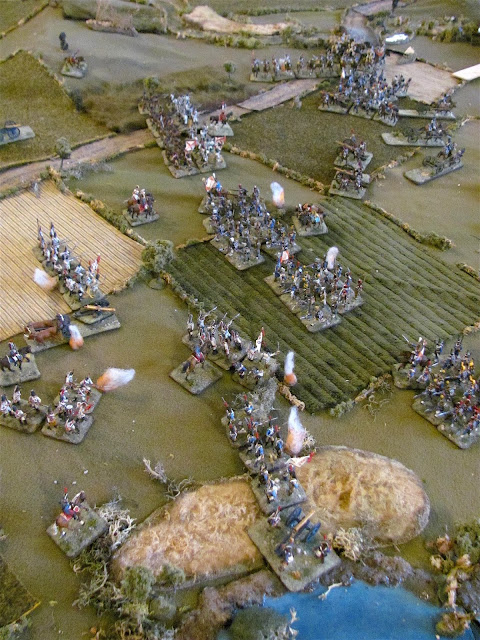Last week we played through, for the first time, a new scenario I had written using the Age of Eagles ruleset. It can be found here on this blog and I have included orbats with troop numbers in case anyone wants to adapt it to their own rule set.
The scenario, based on the battle of Medellin, pits a smaller but more effective French force with superior artillery (the 1st Corps under Marshal Victor) against the Spanish Army of Estremadura commanded by General Cuesta. It was played on a 7.5' X 6' table with 1/72 scale figures, and in this case all the toys came from my cupboard.
The scenario, based on the battle of Medellin, pits a smaller but more effective French force with superior artillery (the 1st Corps under Marshal Victor) against the Spanish Army of Estremadura commanded by General Cuesta. It was played on a 7.5' X 6' table with 1/72 scale figures, and in this case all the toys came from my cupboard.
In the Peninsular War, the Battle
of Medellín was fought on 28 March 1809 and resulted in a
victory of the French under Marshal Victor against
the Spanish under General Don Gregorio Garcia de la
Cuesta. The battle marked the first major effort by the French to
occupy Southern Spain, a feat mostly completed with the victory at
the Battle of Ocana later in the year.
The battlefield was just southeast of
the town of Medellín, roughly 300 km southwest of Madrid.
The Guadiana River ran along a west-east axis on the
northern edge of the battlefield and joined with the Hortiga River,
which ran along a north-south axis that precluded any Spanish
flanking maneuvers on the French right. Victor had roughly 17,500
troops while Cuesta possessed about 23,000. However, Victor had a
50-30 advantage in guns.
Victor deploys three of his 1st Corps divisions so that they span the “y” created by the Rio Hortiga (top) and the Rio Guadiana (bottom). Although the Hortiga is only a stream and easily fordable, its steep banks give a solid anchor to the Trench right while the Guadiana is impassable save by a couple of fords not easily accessed.
Lasalle’s light cavalry, supported by a small contingent of German troops (Baden) from Ruffin’s 3rd Division and two batteries of cannon hold the left (bottom) with Villatte’s strong infantry division in the centre and Latour-Maubourg’s dragoons occupying the high ground on the right, supported by a second contingent of German troops (Nassau) as well as two batteries.
Ruffin’s cannons are also attached to Vilatte’s division, giving him a total of four batteries.
Ruffin’s 1st Division is in reserve outside of Medellin, on the far side of the Hortiga but within an easy march of the French lines.
Cuesta marches his Army of Estramadura onto the battlefield, hugging the Guadiana with his right flank while his cavalry is massed on the left to ward off any incursions from the dragoons the Spanish could see drawn up on the crest of the high ground on this flank.
Seeing the Spanish massed on the French left, Victor orders Ruffin to begin to move his troops over in support while a small contingent of chausseurs ride up from Medellin via Megabril to join the dragoons on the right.
Ruffin brings one of his divisions over the Hortiga to join the main line, but the second fails to receive orders and stays put in Medellin.
The Spanish forces, originally bunched up on the right, begin to shake out into some sort of battle array. Cuesta masses the bulk of his troops on the right along with the majority of his cannon while the remainder move to form supported lines opposite the French centre.
Villalba’s three cavalry brigades advance cautiously, guarding the Spanish left but leaving this part of the French line uncontested. Portago’s division, the weakest of the Spanish troops, form a reserve in the rear, moving forward slowly in fits and starts.
Seeing Victor’s reserve moving to reinforce the French left, Cuesta moves his troops forward rapidly to engage this weakest part of the French line before they can arrive. They push back the Baden troops and force the enemy cannon to limber up and pull back.
In an attempt to stave off the Spanish advance on this flank, Lasalle’s cavalry counterattacks.
The Spanish find it hard to get their artillery into play, especially in the face of the superior French cannon. Two batteries are damaged early, and the others are unable to be easily brought to bear due to the mass of friendly infantry in front of them. With two batteries damaged early the Spanish artillery, already with only five batteries to the French eight, is ineffectual throughout the battle.
With their cannon driven back and the Germans routed on this front, the French reform their line further back. Reinforcements from Ruffin’s division begin to arrive, helping stabilize the line.
Although the Spanish have made some headway they find themselves now boxed in. Cuesta, failing to have demonstrated on the Spanish left, save with cavalry, allows the emboldened French to bring Latour-Maubourg’s cannon to bear on the advancing Spanish infantry as well, ringing them in a deadly hail of cannon fire.
Suddenly an opportunity opens up for the Spanish on their left flank. Latour-Maubourg, seeing Cuesta direct his light cavalry brigade to bolster the attack on the Spanish right, sends his dragoons in a flanking maneuver towards the enemy rear and engages the Spanish heavy cavalry. One of Villalba’s brigades countercharges, holding the French horse at bay while a second takes the opportunity to charge the now unprotected French right flank (top left).
In this overview the Spanish can be seen massed on the French centre and left, but unable to advance as all eight enemy batteries are holding them at bay. Successive attempts to push forward on the Spanish’s right have been thwarted by Lasalle’s cavalry. Now being commanded directly by the charismatic French general, they have charged and countercharged repeatedly, at great cost but effectively holding up the Spanish advance.
On the Spanish left (far left of photo) things get interesting as the French dragoons, having charged towards the Spanish rear, now finds themselves boxed in by Villalba’s dragoons. This gives an opportunity for the Spanish line cavalry (upper left) to charge the exposed enemy flank. Although brought up short, they pass the French cannon intact while the Spanish light horse (seen beside the house model) charge back to this flank as well.
At the bottom Portago wheels the reserve division to guard the Spanish rear.
On the high ground on the French right Latour-Maubourg’s small infantry contingent sees the Spanish line cavalry bearing down on them.
Although the Spanish heavy horse is unable to close, the light horse does, destroying an unattached battery and routing the small German brigade on this flank. Wheeling it destroys a second battery while the line cavalry charge and smash the small chausseur contingent that had moved to this flank.
Completely outflanked the French line looks to be in serious trouble!
This turns out to be the highwater mark for the Spanish. Lasalle’s chausseurs, completely isolated deep in the Spanish lines still manages to drive off attack after attack, even in the face of Spanish cannon fire. The best of the Spanish troops, including the Irlanda regiment, the Royal Spanish and Royal Walloon Guards, assault the French line but are thrown back. They charge again but are decimated by French cannon fire and driven back a second time!
The French line is now redressed in a tight arc from the bridge over the Hortiga to the Guadiana with the river to their backs. Villatte refuses his right flank, pulling back his élite light infantry on this side to thwart the Spanish cavalry’s flanking maneuvers.
Weathering a charge by the Spanish horse and one of Portago's brigades, and tired of the cat and mouse (especially as the cat is being held at bay by the mouse!) that has kept them boxed in the French dragoons maneuver to their left to hopefully take the Spanish heavy horse in the flank.
Victor, seeing the Spanish battered and bruised by French artillery fire, judges it time to take the offensive. Both sides have taken enough casualties that their army’s cohesion is threatening to fall apart, but the Spanish are reeling from a series of failed charges that have left them depleted and in disorder. Also the French general benefits from back to back attacks, meaning he can capitalize on the Spanish disarray before they can rally.
At the bottom, Pathod’s brigade, lead by the the 27th Légere, refuse their flank and disorder the Spanish line cavalry with cannon and musket fire.
Meanwhile Villatte’s still intact second brigade, under Puthod, alongside Ruffin’s two brigades (centre top and top) charges the Spanish to their front along the entire line. Villatte’s cannon (centre) left unsupported, pour fire on a still intact and unattacked Spanish division, disordering them and holding them at bay.
All the French charges are successful! Three brigades are routed in the initial charge and breakthrough charge and the Spanish are sent back reeling.
A Spanish commander desperately tries to rally his fleeing troops in face of the French onslaught.
Meanwhile, on the French right, Pathod’s légere, seeing the enemy line cavalry wavering, close in a charge, routing them completely and leaving only one brigade of Spanish horse on this flank.
The Spanish line cavalry flee back to the high ground in face of the French infantry charge.
The Spanish dragoons are also routed as the entire Spanish army collapses. The French dragoons drive them from the field and then bear down on Portago’s militia.
The French infantry assault along the Guadiana also continues as more Spanish brigades are routed and a battery destroyed.
The battle came to a sudden conclusion with Spanish casualties doubling in the last two turns of play as a result of back to back French turns leaving their entire army in disarray. The Spanish right wing was virtually destroyed in the French counterattacks with only two Spanish infantry brigades (upper centre) still intact in the front line. Portago’s militia division in reserve, still well behind the lines and not in the fight, was still intact although the French dragoons were about to scatter one of those in a headlong charge (far left).
As for cavalry, only the Spanish light horse brigade facing off against Villatte’s light infantry brigade on the French right (top right) was still operational. Spanish artillery, originally five batteries, was reduced to one battery in good shape and a second damaged by game end.
The Spanish threw in the towel at this point as they would now be testing at a -6 as result of losses which would mean that their remaining troops, even those in good order, would almost certainly rout from the field.
French losses, although 30% of their army, were mostly represented in the loss of four small brigades while the remaining five were still largely intact. Lasalle’s light cavalry was a spent force but had finally managed to break out of its encirclement by Spanish forces after doing legion duty in holding off the Spanish right. Latour-Maubourg’s dragoons were still at full strength, ranging behind the shattered Spanish lines and six of the eight French batteries were still in good order.
So, much as the actual battle, a resounding French victory, although for a moment mid-battle it looked as if the Spanish might carry the field.



























Hi Bill, that was an interesting refight, with the Spanish running out of steam as in the real thing. French cavalry can be a bit of a handful for the Spanish.
ReplyDeleteI might have to give Medellin a go at some stage. Lovely looking game as usual.
Cheers
JJ
Thanks, Jonothan,
DeleteYou're right, although I tried a different approach as the Spanish commander it resolved in a similar manner as it did historically, with the French falling back and then delivering a devastating counterattack. The Spanish army just folded like a house of cards!
I've referenced where I found my orbats, by the way, in the bibliography at the end of the scenario, if you ever want to give it a go with your rules. They were from a Spanish source and differed somewhat from Oman, with quite a bit more Spanish horse present.
Great, thanks for pointing that out, I'll add it to my notes.
DeleteWonderful Napoleonic armies, and very interesting battle that I didn't know, thank you for this post.
ReplyDeleteCheers, Phil. I;m glad you enjoyed it.
ReplyDeleteLove it, the terrain, figures, the report. Great stuff mate!
ReplyDeleteThanks, John. I'm glad you enjoyed it.
Delete